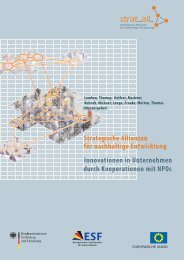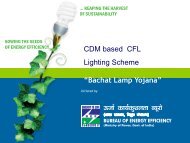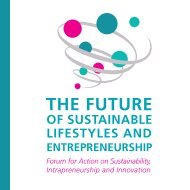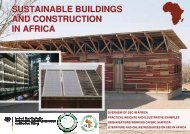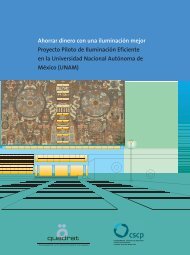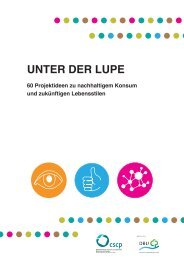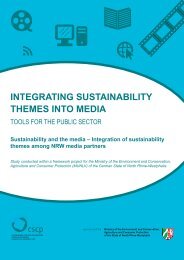today's facts & tomorrow's trends - SPREAD Sustainable Lifestyles ...
today's facts & tomorrow's trends - SPREAD Sustainable Lifestyles ...
today's facts & tomorrow's trends - SPREAD Sustainable Lifestyles ...
You also want an ePaper? Increase the reach of your titles
YUMPU automatically turns print PDFs into web optimized ePapers that Google loves.
When it comes to the installations and appliances inside people’s homes, the<br />
energy efficiency of heating and large electrical appliances has, on average, increased<br />
by 1% and 1.5% respectively over the past decade. The market share of<br />
A-label appliances (indicating that they are the most energy efficient) grew from<br />
just 10% to as high as 90% between 1998 and 2008.<br />
Decentralised renewable energy production has also grown significantly in the<br />
private household sector. The diffusion of solar water heaters, for example,<br />
has soared, reaching an astonishing 75% of households in Cyprus in 2000, with<br />
Greece also making significant progress from 2000 to 2009 (35% of all dwellings<br />
equipped with a solar water heater). In Austria, 24% of dwellings have such<br />
heaters, falling to 11% in Malta and 6% in Germany (Odyssee/Enerdata 2011).<br />
In Spain the Technical Building Code has, since 2006, included an obligation to<br />
meet up to 70% of domestic demand for hot water through solar thermal energy<br />
(for new buildings and major renovations).<br />
Challenges to sustainable<br />
living:<br />
• Increasing number and<br />
size of dwellings<br />
• Existing, energy inefficient<br />
buildings<br />
• High costs, long pay-back<br />
times and complicated<br />
application procedures<br />
for subsidies for building<br />
renovations<br />
• Lack of trustworthy<br />
information and advice for<br />
building renovations<br />
• Growing number of<br />
electricity consuming<br />
appliances in households<br />
• Stimulating and<br />
supporting long-term<br />
behaviour change<br />
• Rebound effects<br />
Challenges to more sustainable living<br />
One over-arching challenge that influences our ability to live in a sustainable<br />
way is our large stock of existing buildings and urban structures. Houses are<br />
built to last and it may take decades before a building is substantially renovated<br />
to reduce energy consumption, or even replaced with a new “nearly zero” or<br />
“energy positive” building. In addition, the building sector is a conservative industry.<br />
It takes time to educate and persuade professionals about the benefits<br />
of new design approaches and to develop effective collaboration between architects,<br />
building material suppliers and the construction industry to foster more<br />
efficient housing.<br />
One particular challenge is the increasing size and number of individual dwellings<br />
(Odyssee/Enerdata 2011). People value comfort, which means space,<br />
warmth and light, with large rooms, high internal temperatures and large windows.<br />
All these factors lead to high levels of energy consumption. This also<br />
means that investments in building renovations, such as loft insulation or new<br />
heating systems, are not always about energy savings, but about creating more<br />
available living space or higher indoor temperatures (Bartiaux 2011).<br />
The energy efficiency of buildings is also challenged by high costs and long payback<br />
times for building renovations. This is exacerbated by a tendency for homeowners<br />
to prioritise immediate gratification over long-term benefits (Breukers<br />
et al. 2009). Another challenge is the owner-occupier issue: who pays for building<br />
renovation and who profits from the (financial) benefits if people do not own<br />
the buildings in which they live? A related challenge is that energy efficiency is<br />
not yet reflected in the market value of a building. The energy performance certificate<br />
of buildings offers potential to influence market values, but its current<br />
intended effect is only the informational aspect.<br />
Promising practices<br />
Promising practice 8: Energy efficient building shells.<br />
Climate adaptive building shells (CABS) are designed to<br />
reduce energy demand while maintaining comfort levels.<br />
These buildings can repeatedly and reversibly change their<br />
functions, features or behaviour over time in response to<br />
changes in performance requirements and external conditions.<br />
54<br />
SUSTAINABLE LIFESTYLES: TODAY’S FACTS & TOMORROW’S TRENDS



